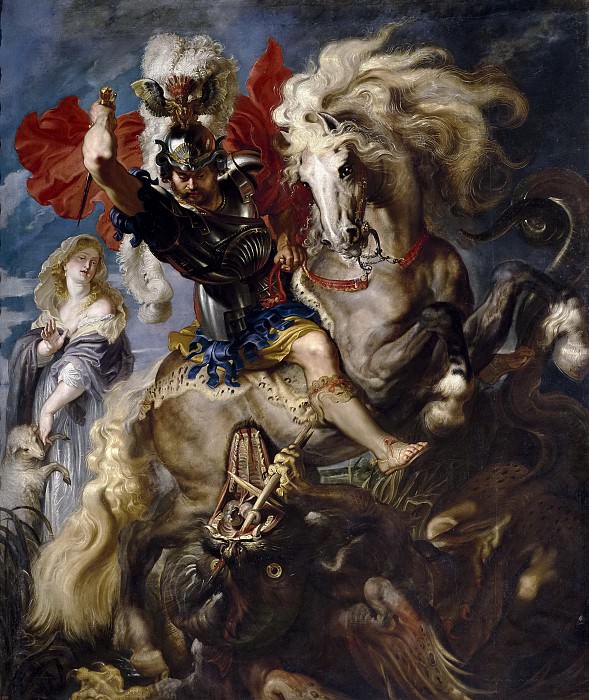Lucha de San Jorge y el dragón Peter Paul Rubens (1577-1640)
Peter Paul Rubens – Lucha de San Jorge y el dragón
Edit attribution
Image taken from other album: gallerix.org/s/907329322/N/120399299/
Download full size: 2281×2711 px (2,4 Mb)
Painter: Peter Paul Rubens
Depicted in the painting, St. George the Victorious embodies the protector of the entire Christian world. According to the legend, an evil king who despised all Christians ruled in one city. He decided to feed all the children of the city to a huge dragon that lived near the settlement. The inhabitants of the city protested, for the king also had a child. The king, determined to placate the people, agreed to also give his daughter to the dragon when it was her turn.
Description of Peter Rubens’ painting St. George and the Dragon
Depicted in the painting, St. George the Victorious embodies the protector of the entire Christian world. According to the legend, an evil king who despised all Christians ruled in one city. He decided to feed all the children of the city to a huge dragon that lived near the settlement. The inhabitants of the city protested, for the king also had a child. The king, determined to placate the people, agreed to also give his daughter to the dragon when it was her turn. The father dressed his only heiress in the most expensive and beautiful clothes and led her to certain death.
In this picture we see the moment when St. George came to the aid of the unfortunate girl. The male figure is depicted on horseback. These are the two central images of the painting. The fearsome animal stands on its pounce, its long blond mane developing in the wind. George is dressed in military armor. His image is very dynamic, a bit pathos and bright.
At the bottom of the picture, a dragon appears before us. It is a huge, dangerous animal with wings, a tail and a terrible toothy mouth. Peter Paul Rubens depicts a small cross consisting of sharp pegs that pierce the dragon’s mouth. This image is very symbolic, because after defeating the dragon, St. George converted almost the entire city to Christianity.
In the background is an image of a princess who was to become a victim of the evil dragon. The girl is shown frightened, but she continues to watch the monster die. Next to the girl, the creator decided to depict a lamb. Thus, the artist wanted to show us that the girl, condemned to death, is as meek and humble as the lamb.
The whole work is imbued with an incredible dynamism. It seems as if the artist was able to photograph the most important moment of the battle. The horse stands on its pounce, St. George draws his sword over his head to strike the fearsome dragon with it.
Кому понравилось
Пожалуйста, подождите
На эту операцию может потребоваться несколько секунд.
Информация появится в новом окне,
если открытие новых окон не запрещено в настройках вашего браузера.
You need to login
Для работы с коллекциями – пожалуйста, войдите в аккаунт (open in new window).















![Peter Paul Rubens - Wolf and Fox Hunt [Workshop]](http://cdn.gallerix.asia/j/_EX/754398988/121989.webp)




COMMENTS: 1 Ответы
Меня поражает безграмотное вмешательство в переведенные названия картин с использованием вспомогательных и заслуживающих абсолютное доверие источников (альбомов, книг, посвященных Рубенсу и его творчеству). Может быть, этим критикам стоит сначала повысить свою квалификацию и уровень знаний?!
You cannot comment Why?
Beneath the horse, the dragon is a terrifying creature, its jaws open, revealing sharp teeth and its body a mass of scales and dark, swirling energy. In the background, a young woman, presumably the princess, stands with a lamb at her side, her expression one of apprehension and perhaps a touch of hope. The contrast between Saint Georges heroic stance and the dragons ferocious presence is stark.
The subtexts of this painting are rich and multifaceted. Primarily, it is a visual representation of the timeless theme of good versus evil, where Saint George symbolizes virtue, courage, and divine intervention, and the dragon embodies the forces of darkness, chaos, and paganism. The presence of the princess and the lamb further emphasizes the theme of rescue and salvation, with Saint George acting as a protector of the innocent and a defender of faith. The intense dynamic and theatricality of the scene may also reflect the Baroque style, emphasizing emotion, movement, and grandeur. This image serves as a powerful allegory for overcoming adversity and the triumph of righteousness.